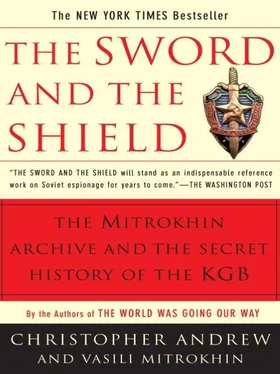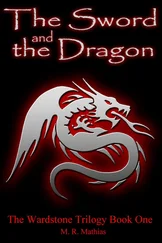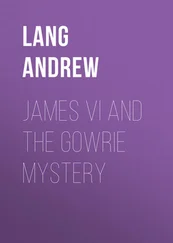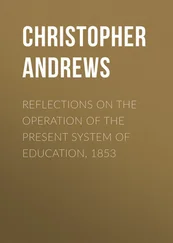Berzin and Buikis, the Cheka agents provocateurs who had helped orchestrate the “envoys’ plot,” subsequently became victims of their own deception. Berzin’s career initially prospered. He was awarded the Order of the Red Banner for his role as agent provocateur, joined the Cheka and later became head of a forced labor camp in the Kolyma goldfields which had one of the highest death rates in Stalin’s gulag. In 1937, however, he was arrested and shot as an enemy of the people. 19The exact charges leveled against Berzin are not known, but it is likely that they included accusations that he had actually collaborated with Western plotters in 1918. In the somewhat paranoid Stalinist interpretation of the “envoys’ plot,” his collaborator Buikis (alias “Shmidkhen”) was portrayed as a covert counter-revolutionary rather than a Cheka officer carrying out his orders. That remained the accepted interpretation even in classified KGB histories during Mitrokhin’s early career. Buikis survived the Terror only by concealing his identity. Not until the mid-1960s did research in the KGB archives reestablish “Shmidkhen’s” true identity and his real role in 1918. 20
Throughout Mitrokhin’s career, KGB historians continued to interpret all plots and attacks against the young Soviet regime as “manifestations of a unified conspiracy” by its class enemies at home and the “imperialist powers” abroad. 21The reality was very different. Had there been “a unified conspiracy,” the regime would surely have lost the civil war. If two or three divisions of Western troops had landed in the Gulf of Finland in 1919, they could probably have forced their way to Moscow and overthrown the Bolsheviks. But in the aftermath of the First World War not even two or three divisions could be found. Those American, British, French and Japanese troops who intervened against the Red Army served mainly to discredit the White cause and thus actually to assist the Bolsheviks. They were too few to affect the military outcome of the civil war but quite sufficient to allow the Bolsheviks to brand their opponents as the tools of Western imperialism. Most Bolsheviks were, in any case, sincerely convinced that during the civil war they had faced a determined onslaught from the full might of Western capitalism. That illusion continued to color Soviet attitudes to the West throughout, and even beyond, the Stalin era.
THE CHEKA’S INTELLIGENCE operations both at home and abroad were profoundly influenced not merely by the legacy of the Okhrana but also by the Bolsheviks’ own pre-Revolutionary experience as a largely illegal clandestine underground. Many of the Bolshevik leadership had become so used to living under false identities before 1917 that they retained their aliases even after the Revolution: among them the Russian nobleman Vladimir Ilyich Ulyanov, 22who kept the pseudonym Lenin, and the Georgian Joseph Vissarionovich Dzhugashvili, who continued to be known as Stalin. Both Lenin and Stalin retained many of the habits of mind developed during their underground existence. On highly sensitive matters Lenin would insist no copy be made of his instructions and that the original either be returned to him for destruction or destroyed by the recipient. Happily for the historian, his instructions were not always carried out. 23
Stalin continued to doctor his own pre-Revolutionary record during the 1920s, changing even the day and year of his birth; the correct date (December 6, 1878) was not made public until 1996. 24During a visit to the secret section of the Moscow Main Archives Directorate (Glavarkhiv), Mitrokhin was once shown an Okhrana file on Dzhugashvili. The file cover and title followed standard Okhrana format, but, on looking inside, Mitrokhin discovered that the contents had been entirely removed. The probability is that the Okhrana had compromising materials on the young Dzhugashvili, and that at the first opportunity Stalin arranged for the file to be gutted. In typical Soviet bureaucratic fashion, however, the cover was preserved since the existence of the file was indelibly recorded in the secret registers. Mitrokhin suspects that whoever emptied the file, presumably on Stalin’s instructions, was later eliminated to preserve the dark secret of its missing contents. 25What Stalin was most anxious to destroy may well have been evidence that he had been an Okhrana informer. Though it falls well short of conclusive proof, a possible trace of that evidence still survives. According to reports from an Okhrana agent discovered in the State Archive of the Russian Federation, Baku Bolsheviks before the First World War “confronted Dzhugashvili-Stalin with the accusation that he was a provocateur and an agent of the Security Police. And that he had embezzled Party funds.” 26
From almost the beginning of the civil war in 1918, in keeping with the Bolshevik tradition of operating under false identities, the Cheka began sending officers and agents under various disguises and pseudonyms behind enemy lines to gather intelligence. By June 1919 the number of these “illegals” was sufficiently large to require the foundation of an illegals operations department (later to become Directorate S of the KGB First Chief Directorate). 27KGB classified histories note that henceforth “illegal” operations became “an inseparable part of foreign intelligence.” On December 20, 1920, the third anniversary of the Cheka’s foundation, a new foreign department (Innostranyi Otdel or INO) was set up to direct all operations beyond Soviet borders. During the early years of Soviet Russia, when the Communist regime remained an international pariah, it had few official missions abroad capable of providing official cover for “legal” intelligence stations (“residencies” in Cheka jargon) and thus relied chiefly on illegals. As diplomatic and trade missions were established in foreign capitals, each was given a “legal residency” headed by a “resident” whose identity was officially communicated only to the ambassador or head of the mission. Illegals, sometimes grouped in “illegal residencies,” operated without the benefit of diplomatic or official cover and reported directly to INO in Moscow. 28
During the civil war of 1918-20, foreign intelligence collection was of minor importance by comparison with the Cheka’s role in assisting the victory of the Red Army over its White enemies. Like the KGB later, the Cheka liked to quantify its successes. In the autumn of 1919, probably the turning point in the civil war, it proudly claimed that during the first nineteen months of its existence it had discovered and neutralized “412 underground anti-Soviet organizations.” 29The Cheka’s most effective method of dealing with opposition was terror. Though its liking of quantification did not extend to calculating the number of its victims, it is clear that the Cheka enormously outstripped the Okhrana in both the scale and the ferocity of its onslaught on political opposition. In 1901, 4,113 Russians were in internal exile for political crimes, of whom only 180 were on hard labor. Executions for political crimes were limited to those involved in actual or attempted assassinations. During the civil war, by contrast, Cheka executions probably numbered as many as 250,000, and may well have exceeded the number of deaths in battle. 30
At the time of the October Revolution, it had never occurred to Lenin that he and the Bolshevik leadership would be responsible for the rebirth of the Okhrana in a new and far more terrible form. In The State and Revolution, which he had almost completed in the summer of 1917, he had claimed that there would be no need for a police force, let alone a political police, after the Revolution. Though it would be necessary to arrange for “the suppression of the minority of exploiters by the majority of wage slaves of yesterday,” such suppression would be “comparatively easy.” The “proletarian dictatorship” which would preside over the rapid destruction of the bourgeois order would require a minimum of rules, regulation and bureaucracy. Lenin had never foreseen the possibility of mass opposition to a revolution carried out in the name of the people. 31But, once in power, he used whatever methods were necessary to retain it, claiming always that the Bolsheviks were defending “the people’s power” and refusing to accept the reality that he had made himself the infallible leader ( Vozhd ) of the world’s first one-party state.
Читать дальше











